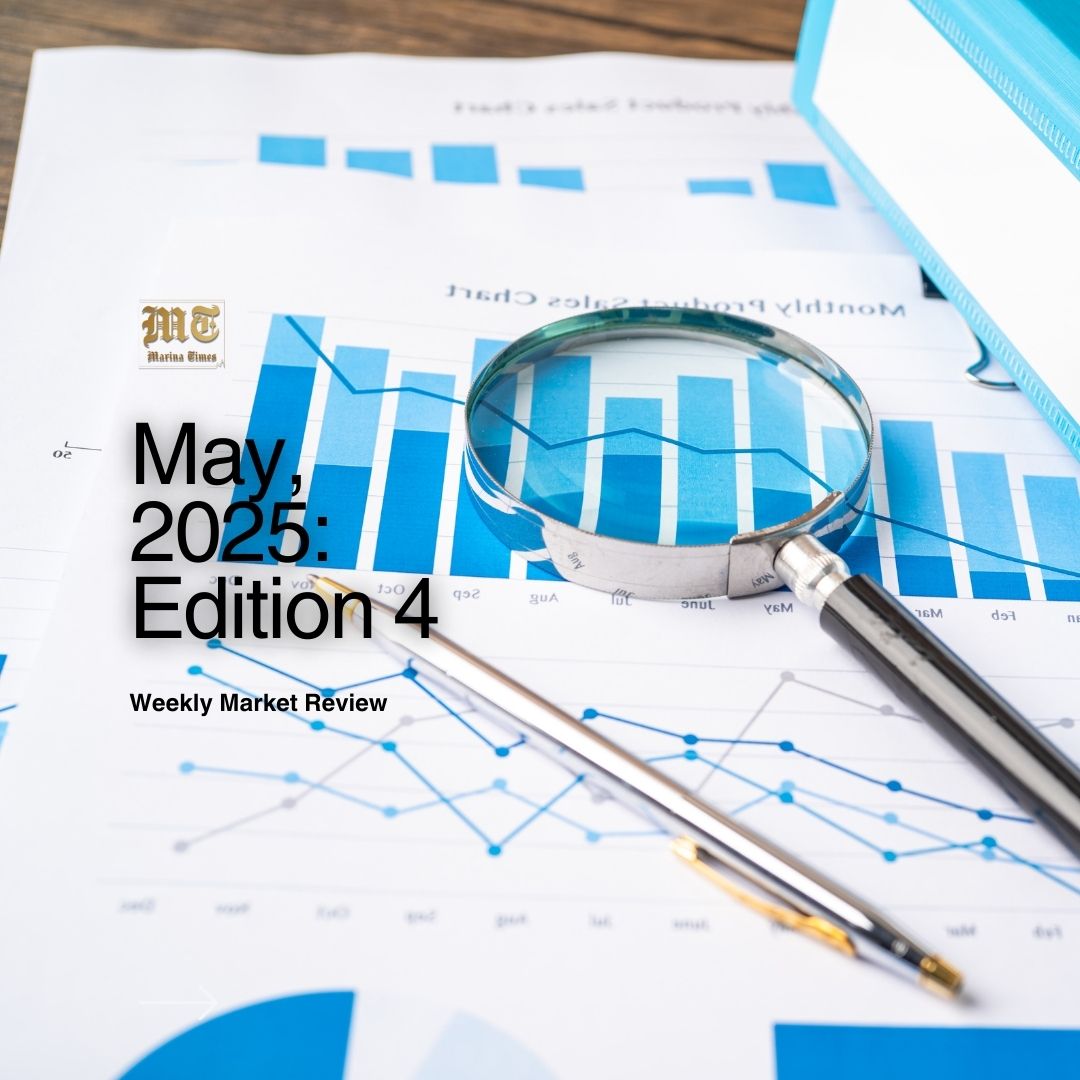

Last Monday and Tuesday, the 300th meeting of the Monetary Policy Committee (MPC), concluded with a decision to maintain all key policy parameters. The Monetary Policy Rate (MPR) held steady at 27.50%, with no changes to other critical instruments. Specifically, the Cash Reserve Ratio (CRR) remains at 50% for Deposit Money Banks and 16% for Merchant Banks. The Asymmetric Corridor continues to operate at +500 basis points above and -100 basis points below the MPR, while the Liquidity Ratio was maintained at 30%.
Today, the Debt Management Office (DMO) is set to offer ₦300 billion worth of Federal Government of Nigeria (FGN) bonds at the auction, a slight reduction from the ₦350 billion offered in April, marking a modest adjustment in the government’s borrowing strategy.
In the week under review, system liquidity improved, and the money market opened on Friday with a surplus of over ₦431.87 billion. Consequently, short-term borrowing rates saw a change: with the Overnight (O/N) rate slightly declining to 26.92% from the previous week’s 26.96%, while the Open Repo Rate (OPR) also decreased to 26.42% from the previous week’s 26.50%. The Naira fluctuated between a high of $/₦1,601.50 on Monday and a low of $/₦1,575.13 on Friday, closing at $/₦1,579.00 on Friday.
Several analysts have noted the MPC’s cautious stance despite a decline in the inflation rate, an easing in the prices of food items, and a relative stabilisation in fuel prices. The cautious stance by the committee comes from inflationary pressures driven by high electricity tariffs and persistent FX demand.
Generally, the MPC’s measured approach reflects a delicate balancing act between maintaining price stability and supporting economic activity. The improving inflation outlook and relative stable fuel prices offer positive signals for gradual economic recovery, potentially enhancing profit margins and boosting business confidence.
During the past week, the Nigerian Naira demonstrated a modest, but notable appreciation against the US Dollar. At the start of the week, the Naira was trading around $/₦1,604.28 on Monday. The following day, coinciding with the conclusion of the Monetary Policy Committee meeting, the currency further experienced a slight appreciation to $/₦1,604.19. However, by mid-week, the Naira had strengthened further, appreciating to $/₦1,594.70 and subsequently to $/₦1,591.30 on Thursday.
Some market observers attribute this incremental gain largely to the MPC’s decision to hold interest rates steady. This move appears to have signalled a degree of stability in monetary policy which, in turn, supported the currency’s performance. The Naira’s resilience is particularly noteworthy given the ongoing volatility in the foreign exchange market and persistent macroeconomic challenges.
Though modest, the Naira’s appreciation is a welcome positive development for Nigeria’s economy and financial market. It could alleviate import costs and help moderate inflation. However, analysts caution that sustained gains will depend on broader structural reforms and consistent policy implementation to address underlying pressures on the foreign exchange market.
Should this trend continue, several positive outcomes may emerge. The sustained Naira strength can help rebuild Nigeria’s foreign exchange reserves, which are crucial for maintaining monetary stability and defending the currency against speculative pressures. A healthier reserve position also increases the Central Bank’s capacity to intervene effectively in the foreign exchange market when necessary.
The Nigerian Treasury Bills (NTBs) auction held on the 21st of May, 2025, presented a clear picture of investor sentiment across different tenors. For the 91-day bill, the Central Bank offered ₦50 billion, with subscriptions totalling approximately ₦72.56 billion. The stop rate was maintained at 18.00% with an allotment of 98.77% of the total subscription. This outcome indicates robust demand, with investors subscribing to about 43% more than what was on offer.
In contrast, the 182-day bill saw a much lower interest. The offer stood at ₦100 billion, but subscriptions amounted to only ₦46.84 billion, less than half of the amount on offer. The amount allotted was ₦41.13 billion, which is about 87.81% of the total subscription. Again, the stop rate was set at 18.50%.
However, the 364-day bill attracted the most significant attention from investors. The offer was ₦350 billion, but subscriptions soared to over ₦1.05 trillion, three times the amount on offer. The DMO allotted ₦503 billion, which is substantially higher than the original offer, but less than half of the total subscriptions, indicating a highly competitive process. Although the stop rate was the highest among the three, at 19.56%, it was still 7 basis points below where it closed at the previous auction.
AUCTION DATE | 21-05-2025 | 21-05-2025 | 21-05-2025 |
ALLOTMENT DATE | 22-05-2025 | 22-05-2025 | 22-05-2025 |
MATURITY DATE | 21-08-2025 | 20-11-2025 | 21-05-2026 |
TENOR | 91-DAY | 182-DAY | 364-DAY |
OFFER (₦) | 50,000,000,000 | 100,000,000,000 | 350,000,000,000 |
SUBSCRIPTION (₦) | 72,560,054,000 | 46,840,162,000 | 1,052,180,165,000 |
ALLOTMENT (₦) | 71,668,052,000 | 41,134,504,000 | 503,001,321,000 |
STOP RATES (%) | 18.0000 | 18.5000 | 19.5600 |
PREVIOUS STOP RATES (%) | 18.0000 | 18.5000 | 19.6300 |
The Central Bank of Nigeria also conducted the Open Market Operations (OMO) auction on Tuesday, May 20th, 2025. For the 182-day OMO bill, the Central Bank offered ₦250 billion. However, total subscriptions amounted to ₦172.5 billion, which is significantly below the amount on offer, and only ₦117.5 billion was allotted. The stop rate was set at 23.77%, an increase of 112 basis points when compared to the previous auction. The high stop rate, in comparison to recent Treasury Bill auctions, suggests that investors are demanding a much higher yield to hold this OMO paper.
For the 210-day OMO bill, we saw much stronger investor interest. The offer was also ₦250 billion, but subscription soared to ₦570.75 billion, more than double the offer. The Central Bank allotted ₦537.75 billion, which is more than twice the original offer, and the stop rate was marginally higher than the 182-day at 23.98%, a rise of 126 basis points from where the last auction closed.
Both tenors cleared at high stop rates, reflecting the current tight monetary conditions and heightened yield expectations in the market. This begs the question as to whether the market is back to the 24.00% level. The Central Bank’s decision to allot significantly more than the initial offer in both auctions suggests a strategic approach to liquidity management and government funding, but the rising yields may also signal increasing pressure on public finances and the need to monitor inflation and monetary policy expectations closely.
TENOR | AUCTION DATE | OFFER (₦’ B) | BIDS (₦’ B) | RANGE OF BIDS (%) | STOP RATES (%) | PREVIOUS STOP RATES (%) | TOTAL SALE (₦’ B) |
182-DAY | 20-05-2025 | 250.00 | 172.50 | 21.7000-24.2000 | 23.7700 | 22.6500 | 117.50 |
210-DAY | 20-05-2025 | 250.00 | 570.75 | 22.0000-24.5000 | 23.9800 | 22.7200 | 537.75 |
On offer for the May 2025 FGN Bond are two reopened bonds designed to attract a broad spectrum of investors. The first is the 5-year bond maturing in April 2029 and a target to raise ₦100 billion from this issuance, halving the amount offered in April. The second is the 9-year bond maturing in May 2033, from which the DMO targets ₦200 billion, an increase of about 33.3% compared to the previous auction.
At the last auction in April, the May 2033 bond closed at 19.99%, while the April 2029 bond closed at 19.00%. Market participants are keenly watching to see where these bonds will settle at the close of the May auction, especially with the anticipation of new issuances scheduled for June. These new issuances will introduce fresh 5- and 7-year tenored bonds maturing in January 2030 and January 2032 respectively, which are expected to further diversify the government’s debt portfolio.
Although this will not be the first time the DMO decides to offer less than what was offered at the previous auction, market participants are asking if this could be an approach by the government to manage its domestic borrowing needs while responding to investor appetite and market conditions. The government’s decision to reduce the amount raised from the 5-year bond while increasing the issuance of the longer-dated 9-year bond suggests a deliberate effort to extend debt maturities.
This approach is prudent, as it helps to mitigate short-term refinancing risks and spreads repayment obligations over a longer time. The introduction of new five- and seven-year bonds in the upcoming June auction further shows the government’s intent to diversify its debt portfolio.
Despite the positives seen with the Naira, the appreciation remains fragile and is subject to external shocks such as fluctuations in global oil prices, which heavily influence Nigeria’s foreign exchange earnings. To this effect, sustained progress will require consistent policy measures, enhanced foreign exchange market management, and broader economic reforms to build resilience against future shocks.
As markets look forward to the results of the recently closed Sukuk, there are strong indications that the issue was largely oversubscribed. If allotment is pegged to what was originally offered (even with some allowance), there is a big chance that excess demand for similar duration will trickle into the market. Based on the notion that the June auction will not feature the 19.89% 2033 bond, it is our expectation that most portfolio managers will dive-in to get a piece of the market’s highest yielding bond at its last issue.
On the global front, oil and cryptocurrencies have remained largely bullish, albeit with notable volatility. This trend is particularly significant for Nigeria, as the country relies heavily on crude oil exports for government revenue and foreign exchange earnings. A bullish oil market translates to improved national income and most likely a better fiscal stability.
Although Nigeria has a somewhat cautious regulatory stance on crypto, many Nigerians are among the most active crypto users globally. Bullish trends in crypto markets can affect personal wealth and informal financial activity in the country, particularly among the youth.
Shall We Hold Our Breath?
They stay awake all night trading crypto; anxious, biting their fingernails, their tired, puffy eyes—result of constant rubbing. Coffee is their favourite companion, just to stay awake long enough to make that deal.
The youth! No more cup in hand, begging for a job. They’ve found another way… the crypto way.
Sadly, the administration is only paying lip service. Minimal regulations have been thrown at it, increasing the peril of scams and fraud.
But quietly, the crypto market is rising—creating livelihoods for the youth.
Very soon, crude oil might not be the only egg in the basket. So… shall we hold our breath?
- Sandra A. Aghaizu